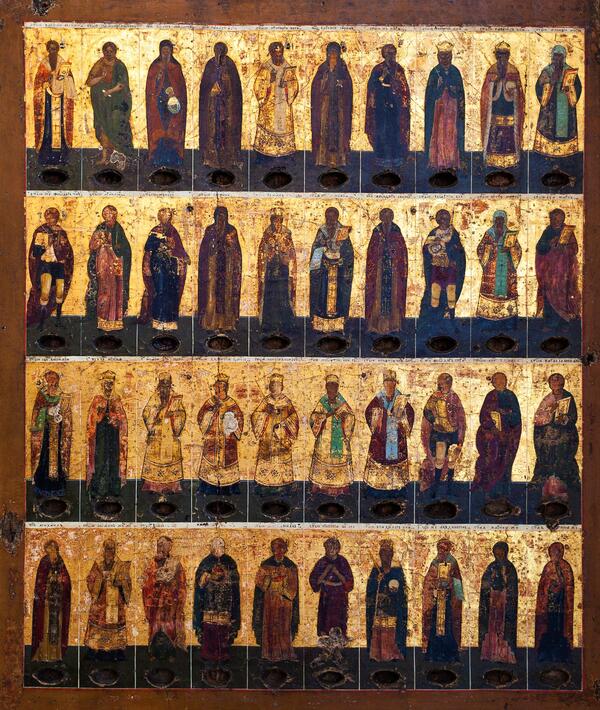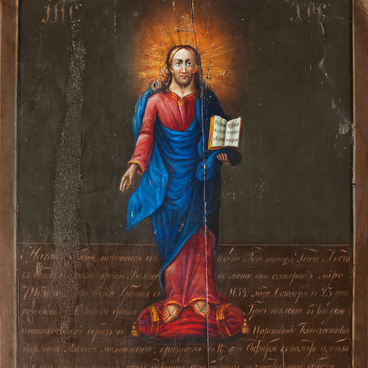One of the most unusual artefacts housed in the Tomsk Art Museum is a large-scale icon with recesses for relics, which depicts forty saints: apostles, saints, martyrs and holy wives, whose remains at one time were moved to Tomsk.
Ivan Kachanov, an aristocrat, brought the relics from Moscow in 1703. He placed 83 large pieces in the church he built at the same time. The church was erected in honor of the first Siberian shrine — the icon ‘The Mother of God Abalakskaya’ of the ‘Our Lady of the Sign’ iconographic type (‘Znamenie’) in the Zaozerny district.
The relics were kept for a century and a half in special boxes on wax-mastic (a mixture of beeswax and other ingredients), until 1848 when Athanasius Bishop of Tomsk and Yenisey commissioned two icons from Moscow with full-length images of saints and with recesses for a kovcheg — an ark (an icon with a recessed central area).
The arks are silver and gilded rounded boxes, which protrude along the edges of the icon. Usually, parts of the relics of the saints depicted on the image are kept within them. Other sacred objects linked to the depicted are also placed there: clothes, fragments of coffins, stones from the areas where the New Testament events took place. In February 1922, the state-ordered confiscation and nationalization of church possessions began. The remains were most likely simply destroyed, just like many other shrines in Russia.
The figures on the icon are painted in light layers. The peculiarities of the style of the images — clear contour lines, harmonious proportions of slightly elongated figures and subdued color combinations — are characteristic of the Moscow icon painting school.
The icon is subordinated to the architectural design of the church. Three panels are fastened with strong mortise oak slats (‘shponki’ in Russian). They are primed with smooth ivory-colored levkas — a mixture of chalk, animal or fish glue and linseed oil. It was traditionally used as a base for gilding icons with gold leaf.
Before applying the levkas, the pavoloka was glued onto the icon surface, so that the image became more durable. The pavoloka, which comes down to the lower end of the icon, is a cotton cloth, similar to calico. It confirms the time of creation indicated in several sources — the middle of the 19th century, as in the 16th and 17th centuries, icon painters used ‘vetoshki’ or rags instead (old, but still durable fabrics).
The gold background of the icon serves both as color and light at the same time. It symbolizes the radiance of the divine glory in which the saints dwell. This light permeates everything in the icon and falls in lines of gold leaf on the folds of clothes.
The surface of the icon is divided into forty even rectangles with figures of saints depicted in them. The objects in their hands indicate their feats, martyrdom or glorification. The vestments also represent the saints’ service and correspond to each rank (or saint title), that is one can determine who the saints were during their lives — prelates, apostles, tsars, princes, monks or schemamonks.
The soldiers are represented in military clothes with crosses in their hands — symbols of suffering for Christ. The holy fathers and doctors of the church are depicted in episcopal vestments with uncovered heads and the Holy Scripture in their hands. The apostles stand barefoot in their chitons and himations; with both hands they hold closed books of the Holy Scripture. The first Metropolitans of Moscow are depicted in bishop’s vestments, white headdresses and with the Scripture in their hands.
Ivan Kachanov, an aristocrat, brought the relics from Moscow in 1703. He placed 83 large pieces in the church he built at the same time. The church was erected in honor of the first Siberian shrine — the icon ‘The Mother of God Abalakskaya’ of the ‘Our Lady of the Sign’ iconographic type (‘Znamenie’) in the Zaozerny district.
The relics were kept for a century and a half in special boxes on wax-mastic (a mixture of beeswax and other ingredients), until 1848 when Athanasius Bishop of Tomsk and Yenisey commissioned two icons from Moscow with full-length images of saints and with recesses for a kovcheg — an ark (an icon with a recessed central area).
The arks are silver and gilded rounded boxes, which protrude along the edges of the icon. Usually, parts of the relics of the saints depicted on the image are kept within them. Other sacred objects linked to the depicted are also placed there: clothes, fragments of coffins, stones from the areas where the New Testament events took place. In February 1922, the state-ordered confiscation and nationalization of church possessions began. The remains were most likely simply destroyed, just like many other shrines in Russia.
The figures on the icon are painted in light layers. The peculiarities of the style of the images — clear contour lines, harmonious proportions of slightly elongated figures and subdued color combinations — are characteristic of the Moscow icon painting school.
The icon is subordinated to the architectural design of the church. Three panels are fastened with strong mortise oak slats (‘shponki’ in Russian). They are primed with smooth ivory-colored levkas — a mixture of chalk, animal or fish glue and linseed oil. It was traditionally used as a base for gilding icons with gold leaf.
Before applying the levkas, the pavoloka was glued onto the icon surface, so that the image became more durable. The pavoloka, which comes down to the lower end of the icon, is a cotton cloth, similar to calico. It confirms the time of creation indicated in several sources — the middle of the 19th century, as in the 16th and 17th centuries, icon painters used ‘vetoshki’ or rags instead (old, but still durable fabrics).
The gold background of the icon serves both as color and light at the same time. It symbolizes the radiance of the divine glory in which the saints dwell. This light permeates everything in the icon and falls in lines of gold leaf on the folds of clothes.
The surface of the icon is divided into forty even rectangles with figures of saints depicted in them. The objects in their hands indicate their feats, martyrdom or glorification. The vestments also represent the saints’ service and correspond to each rank (or saint title), that is one can determine who the saints were during their lives — prelates, apostles, tsars, princes, monks or schemamonks.
The soldiers are represented in military clothes with crosses in their hands — symbols of suffering for Christ. The holy fathers and doctors of the church are depicted in episcopal vestments with uncovered heads and the Holy Scripture in their hands. The apostles stand barefoot in their chitons and himations; with both hands they hold closed books of the Holy Scripture. The first Metropolitans of Moscow are depicted in bishop’s vestments, white headdresses and with the Scripture in their hands.



